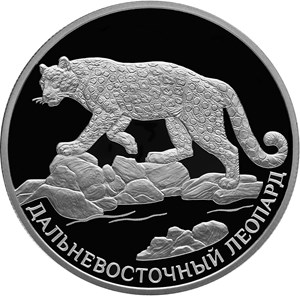Amur Leopard
Obverse
the mirror field of the disc bears a relief image of the National Coat of Arms of the Russian Federation, over it along the rim there is the semicircular inscription "РОССИЙСКАЯ ФЕДЕРАЦИЯ" (RUSSIAN FEDERATION) framed on both sides by doubled rhombuses, below under the coat of arms there are indications of the precious metal and its fineness on the left and the fine metal content and the mint trade mark on the right, at the bottom in the centre, in three lines, there is an inscription "БАНК РОССИИ" (BANK OF RUSSIA), the denomination of the coin "2 РУБЛЯ" (2 RUBLES), and the year of issue "2019 г." (2019).
Reverse
the mirror field of the disc bears a relief image of the Amur leopard; at the bottom there is a semicircular inscription: "ДАЛЬНЕВОСТОЧНЫЙ ЛЕОПАРД" (AMUR LEOPARD).
Authors
The artists: E.V. Kramskaya (obverse), F.S. Andronov (reverse).
The sculptors: A.A. Dolgopolova (obverse), F.S. Andronov (reverse).
Mint: Saint Petersburg Mint (СПМД).
The edge: 195 corrugations.
Discover more
Series: Red Data Book
Amur Leopard
Catalogue number: 5110-0158
The Amur leopard (Panthera pardus orientalis) is a feline carnivore and one of leopard subspecies. It is critically endangered.
The global population of the Amur leopard does not exceed 40-52 individuals. The Amur leopard is native to the south of the Russian Far East, woodlands and mountain areas of the north-eastern China and the Korean Peninsula. Currently, the south-west of the Primorye Territory remains the only proved habitat of the Amur leopard in Russia. The main threats include poaching, insufficient food supplies, and habitat destruction and loss.
Leopards inhabit mountain areas covered with cedar, oak and fir forests. Random felling of coniferous trees, as well as oaks and ash trees, coupled with new road building steadily reduces the habitat of the Amur leopard.
The hunt on leopards has been banned since 1956, and their capture, since 1966.
Source: http://www.mnr.gov.ru


